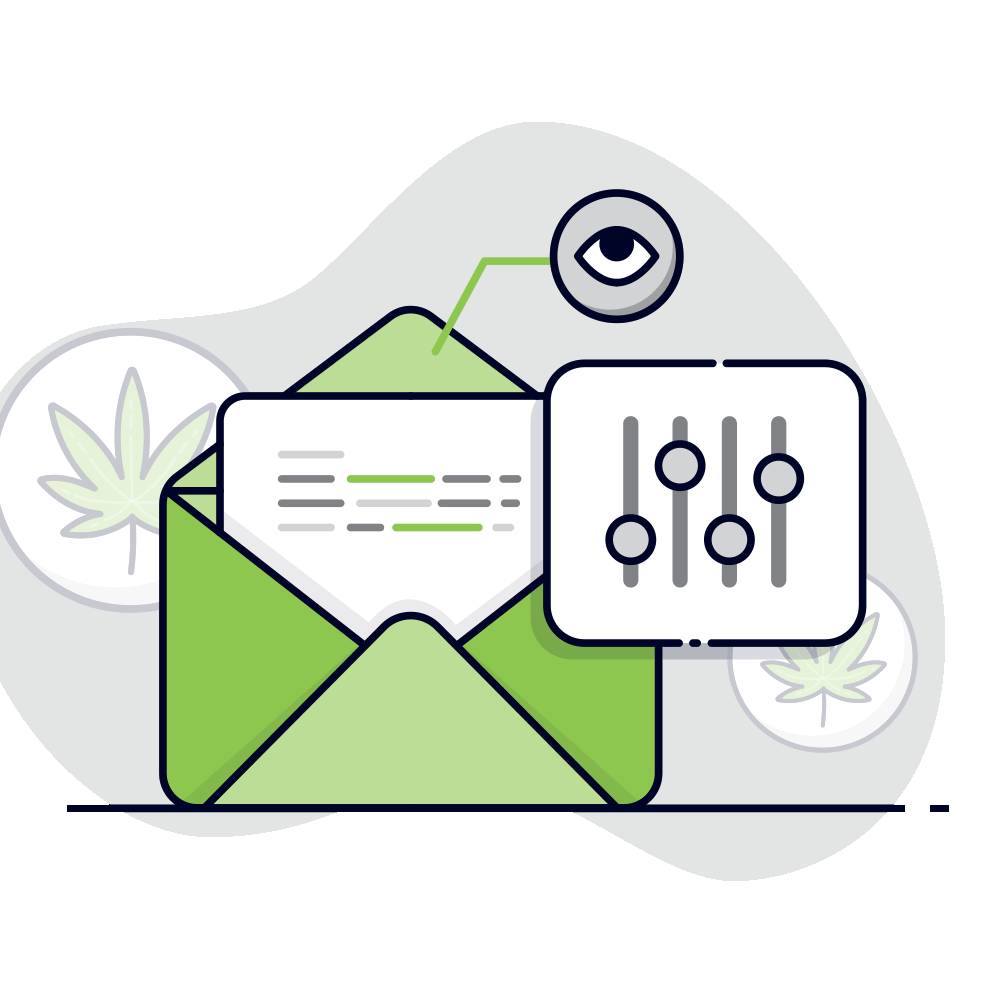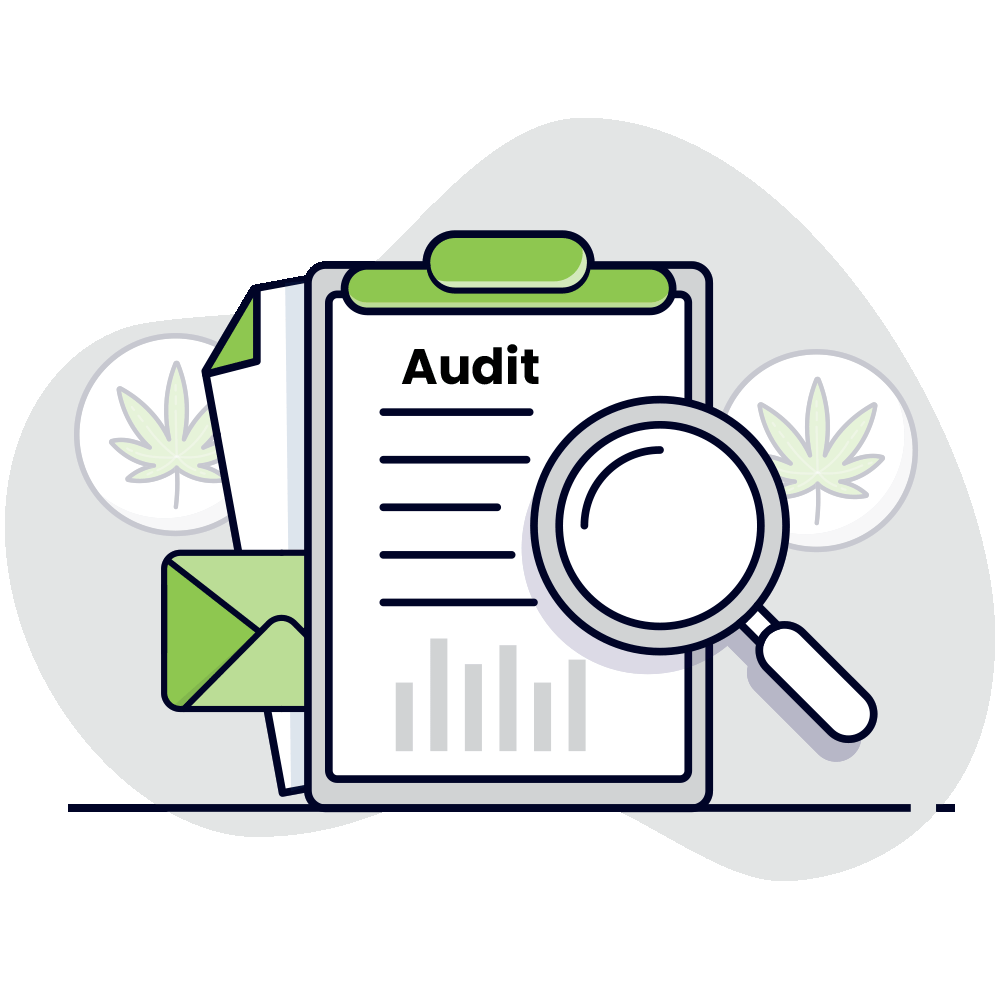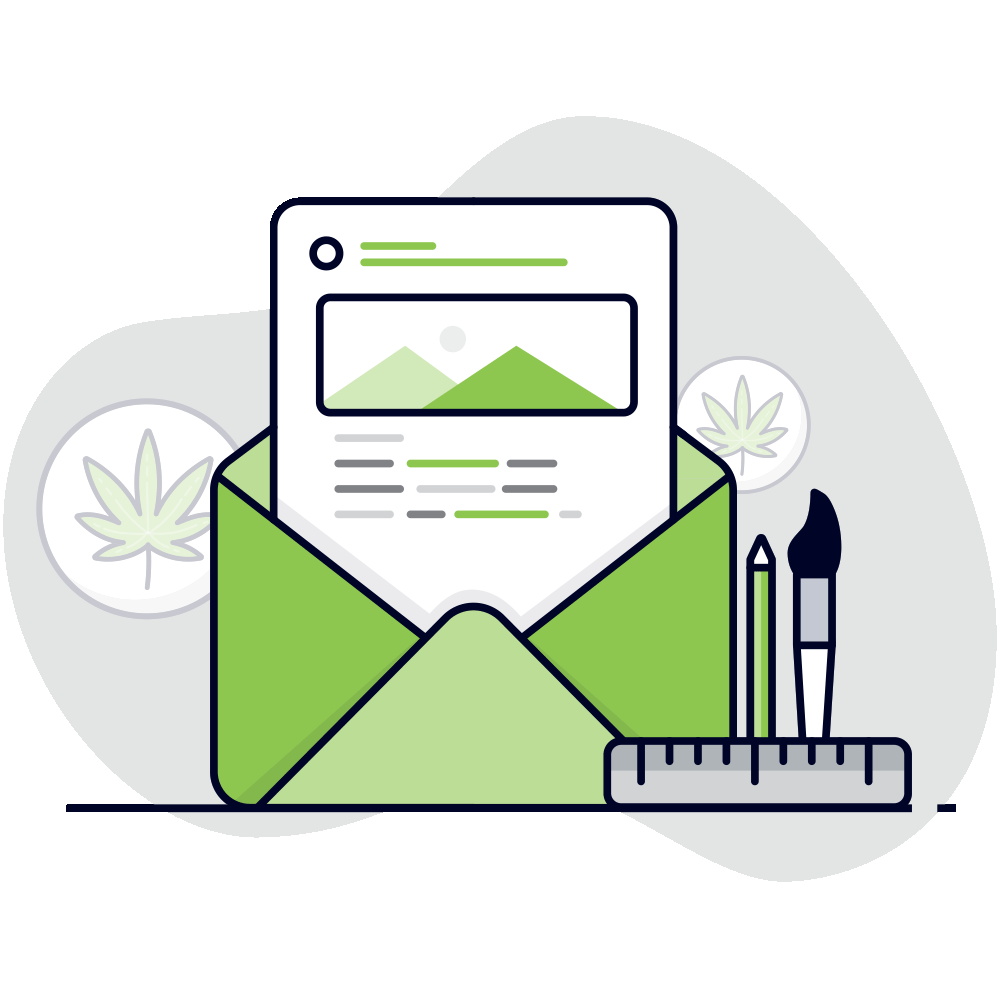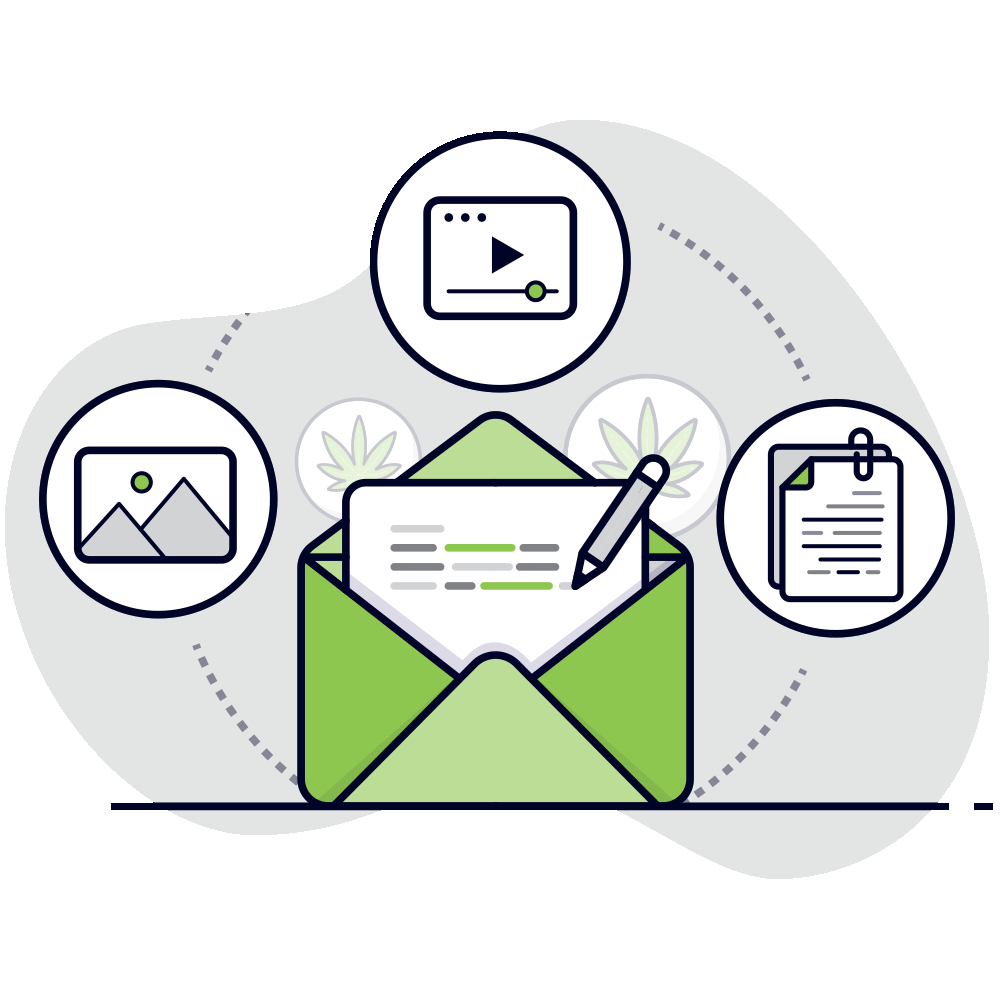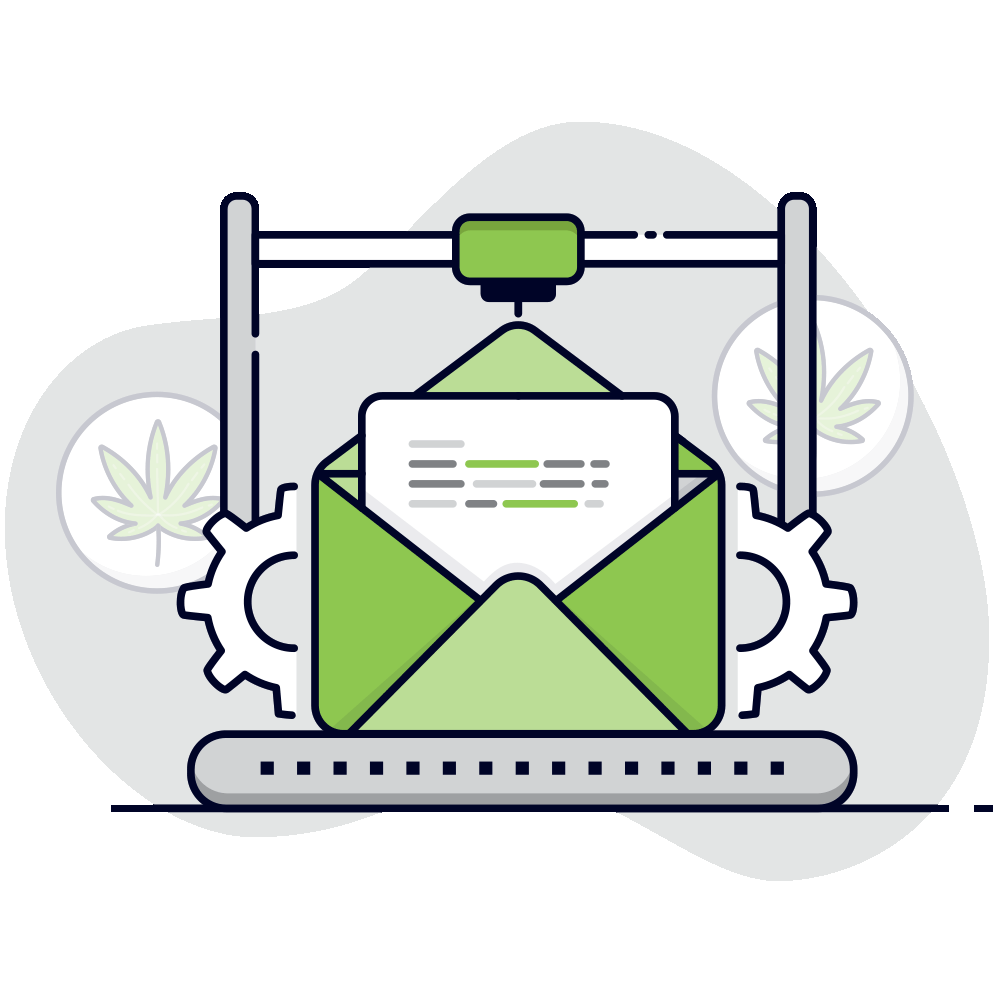HOW-TO GUIDE
Smoke Shop Email Marketing Guide
Unlock the secrets of powerful email marketing for your smoke shop with our comprehensive guide. From high-ROI strategies to industry case studies, discover the path to success today!
Download the eBook
IN THIS GUIDE:
- Download the eBook
- Understanding Email Marketing
- Email Marketing vs. Other Marketing Methods
- Measuring the ROI of Email Marketing
- Building and Growing Your Email List
- Crafting Effective Email Campaigns
- Automation and Workflow
- Measuring and Improving Email Campaign Performance
- Best Practices for Smoke Shop Email Marketing
- Download eBook
Welcome to the world of email marketing for smoke shops! In this guide, we will explore the ins and outs of using email marketing to promote and grow your smoke shop business. This introduction sets the stage for what you can expect from this comprehensive guide.
This guide is designed to be a valuable resource for smoke shop owners and marketers who want to harness the power of email marketing. We will delve into the various aspects of email marketing, from understanding the fundamentals to building effective campaigns, measuring your success, and integrating email marketing with other strategies. Our goal is to provide you with the knowledge and tools you need to make the most of this digital marketing channel.
The Importance of Email Marketing for Smoke Shops
Email marketing has emerged as one of the most powerful and cost-effective marketing tools available today. For smoke shops, it offers a direct line of communication with your customers and a platform to engage, inform, and build lasting relationships. Email marketing can help you reach a targeted audience, increase brand awareness, and ultimately boost your sales and customer loyalty. It is a strategy that can make a significant impact on your business’s success.
What to Expect from This Guide
In the following chapters, we will cover a wide range of topics related to email marketing specifically tailored to the smoke shop industry. You can expect to find:
- Insights into the fundamentals of email marketing.
- Comparisons of email marketing with other digital marketing methods.
- Guidance on measuring the return on investment (ROI) of your email marketing efforts.
- Strategies for building and growing your email subscriber list.
- Tips for creating effective email campaigns that resonate with your audience.
- Information on automation, workflow, and performance measurement.
- Best practices for email marketing in the smoke shop niche.
- Real-world case studies and examples.
- Tools and resources to help you get started and succeed.
This guide is your comprehensive resource for leveraging the power of email marketing for your smoke shop. Whether you’re new to email marketing or looking to optimize your current strategies, this resource will provide you with the knowledge and practical advice you need to thrive in the digital age. So, let’s dive in and discover how email marketing can take your smoke shop business to new heights!
Understanding Email Marketing
In the digital age, email marketing has emerged as a powerful tool for businesses across various industries, including smoke shops. In this chapter, we will explore the fundamentals of email marketing, its specific role within the smoke shop industry, and the numerous benefits it offers to smoke shop owners and marketers.
What Is Email Marketing?
Email marketing is a direct and highly effective form of digital marketing that involves sending commercial messages to a group of individuals via email. These messages can vary widely, from promotional offers and product updates to newsletters and customer engagement campaigns. The essence of email marketing lies in establishing a direct line of communication with your customers or potential customers, enabling you to reach them in a more personalized and targeted manner.
The Role of Email Marketing in the Smoke Shop Industry
In the smoke shop industry, email marketing plays a vital role in connecting with your customer base. Here’s how it can benefit your smoke shop:
- Customer Engagement: Email marketing provides a platform to engage with your customers, keeping them informed about new product arrivals, upcoming promotions, and industry trends. It allows you to foster a sense of community among your clientele.
- Promotions and Sales: Smoke shops often run promotions, sales, and special events. Email marketing is an excellent way to notify your customers about these offers and encourage them to make purchases.
- Product Updates: As the smoke shop industry evolves, new products and accessories are constantly introduced. Email marketing allows you to showcase these new arrivals and keep your customers up-to-date on the latest trends and innovations.
- Brand Loyalty: Building brand loyalty is essential in a competitive market. Consistently communicating with your customers via email helps strengthen their loyalty to your smoke shop, making them more likely to choose your products over competitors.
Benefits of Email Marketing for Smoke Shops
Email marketing offers a plethora of benefits to smoke shops. Some of the key advantages include:
- Cost-Effective: Compared to traditional advertising methods, email marketing is budget-friendly. You can reach a large audience with minimal costs, making it a cost-effective way to promote your smoke shop.
- Direct Communication: With email marketing, you have a direct line of communication with your customers. This direct channel enables you to convey your messages without intermediaries.
- Targeted Marketing: Email marketing allows for precise targeting. You can segment your email list based on customer preferences, demographics, and behavior, ensuring that your messages are highly relevant to each recipient.
- Measurable Results: Unlike many traditional advertising methods, email marketing provides detailed metrics to track the success of your campaigns. You can measure open rates, click-through rates, conversion rates, and more, allowing you to make data-driven improvements.
Automation and Personalization: Email marketing platforms offer automation features, enabling you to send personalized emails at scale. Automation saves time and ensures that your customers receive relevant content.
In this chapter, we’ve covered the basics of email marketing, its role in the smoke shop industry, and the benefits it offers. As you continue through this guide, you’ll delve deeper into the strategies and best practices that will help you harness the full potential of email marketing for your smoke shop.
Email Marketing vs. Other Marketing Methods
In this chapter, we will explore how email marketing stacks up against other marketing methods. We’ll compare email marketing to traditional advertising, social media marketing, and search engine optimization (SEO) to highlight the unique advantages that email marketing offers to smoke shops.
Comparing Email Marketing to Traditional Advertising
Traditional advertising methods, such as print media, billboards, and television commercials, have been staples of marketing for decades. However, they often come with significant limitations, especially for smoke shops.
Cost Efficiency: Traditional advertising can be costly, and the return on investment is not always easy to measure. In contrast, email marketing is a cost-effective method, allowing you to reach a large audience with minimal expenses.
Targeting: Email marketing provides precise targeting options. You can segment your email list to send tailored messages to specific customer groups. Traditional advertising often lacks this level of targeting, leading to a broader and less focused audience.
Interactivity: Email marketing allows for direct interaction with customers. You can encourage recipients to take immediate action, such as visiting your website, making a purchase, or engaging with your content. Traditional advertising tends to be more passive, with limited interactivity.
Measurability: Email marketing provides detailed metrics, allowing you to measure the success of your campaigns accurately. Traditional advertising often lacks this level of transparency, making it challenging to assess the effectiveness of your efforts.
Social Media Marketing vs. Email Marketing
Social media marketing has gained prominence as a way to engage with audiences and build brand recognition. While social media has its merits, email marketing offers unique advantages for smoke shops.
Direct Ownership: With email marketing, you own your list of subscribers, and you have full control over your communication. Social media platforms, on the other hand, can change algorithms and policies, affecting your reach and engagement.
Personalization: Email marketing allows for highly personalized messages, enabling you to cater to the individual preferences of your subscribers. Social media is more public and may not offer the same level of personalization.
Audience Reach: While social media can help you reach a broad audience, email marketing often reaches a more engaged and targeted group of individuals who have willingly opted to receive your messages.
SEO and Email Marketing: A Synergistic Approach
Search engine optimization (SEO) is crucial for enhancing your online visibility and driving organic traffic to your website. When combined with email marketing, these two strategies can work together to achieve better results.
Content Distribution: Email marketing can be used to distribute valuable content to your subscribers, driving traffic to your website and improving your SEO efforts.
Link Building: Emails can include links to your website or specific landing pages, aiding in link building efforts that contribute to your website’s search engine ranking.
User Engagement: Engaged email subscribers who click through to your website and spend time on it can positively influence your search engine rankings.
Social Sharing: Email content can be easily shared on social media, expanding your reach and potentially driving more traffic to your website.
In this chapter, we’ve compared email marketing to traditional advertising, social media marketing, and SEO. While these methods each have their strengths, email marketing stands out for its cost-efficiency, targeting capabilities, interactivity, measurability, and the ownership it grants over your audience. Additionally, when combined with SEO, email marketing can bolster your online presence and deliver enhanced results for your smoke shop.
Measuring the ROI of Email Marketing
Understanding the return on investment (ROI) of your email marketing efforts is essential for assessing the success of your campaigns and optimizing your strategies. In this chapter, we’ll delve into the concept of ROI, how email marketing can provide a high ROI for smoke shops, and the methods for tracking and analyzing the results.
Defining Return on Investment (ROI)
ROI is a fundamental metric that measures the profitability of your marketing campaigns. It quantifies the gains or losses generated from your investments and is expressed as a percentage of the initial investment. In the context of email marketing for smoke shops, ROI is calculated by comparing the revenue generated from your email campaigns to the costs associated with those campaigns.
The ROI formula is as follows:
In simple terms, a positive ROI means that your email marketing efforts are generating more revenue than they cost, while a negative ROI indicates that your campaigns are not delivering a profitable return.
How Email Marketing Can Deliver High ROI
Email marketing has the potential to offer a high ROI for smoke shops due to several key factors:
- Low Costs: Email marketing is cost-effective. It involves minimal expenses for creating and sending emails compared to traditional advertising methods.
- Targeted Campaigns: You can precisely target your audience based on their preferences, behaviors, and demographics. Targeted emails are more likely to resonate with recipients and lead to conversions.
- Personalization: Email marketing enables you to personalize your messages. Personalized content is more engaging and effective at building customer relationships.
- Automation: Email marketing platforms offer automation capabilities, allowing you to schedule and send emails at optimal times, nurture leads, and re-engage customers automatically.
- Measurable Metrics: Email marketing provides detailed metrics that allow you to measure the performance of your campaigns. You can track open rates, click-through rates, conversion rates, and revenue generated, making it easy to assess your ROI.
- High Conversion Rates: Well-crafted email campaigns, especially those that promote limited-time offers and exclusive deals, often result in high conversion rates. These conversions translate into revenue.
Tracking and Analyzing Your Email Marketing Efforts
To measure the ROI of your email marketing campaigns effectively, it’s crucial to track and analyze your efforts. Here are some key steps in the process:
- Set Clear Objectives: Define specific goals for each email campaign, whether it’s to increase sales, boost website traffic, or enhance brand awareness. Having clear objectives makes it easier to assess ROI.
- Use Analytics Tools: Employ email marketing platforms that provide robust analytics tools. These tools will help you track essential metrics, such as open rates, click-through rates, and conversion rates.
- Segment Your Data: Analyze the performance of different email campaigns and segments. This data segmentation allows you to identify what strategies are working and which may need adjustments.
- Calculate ROI: Use the ROI formula mentioned earlier to assess the profitability of each campaign. Consider both the revenue generated and the total costs, including design, copywriting, and email platform expenses.
- A/B Testing: Experiment with different elements of your emails, such as subject lines, content, and call-to-action buttons, using A/B testing. This method helps you determine what resonates most with your audience and improves ROI over time.
Continuous Improvement: Regularly review your email marketing campaigns’ performance and ROI. Make data-driven decisions and optimize your strategies to enhance your results.
Measuring the ROI of your email marketing campaigns is an ongoing process that allows you to refine your tactics and maximize the return on your investments. By understanding the financial impact of your email marketing efforts, you can make informed decisions to grow your smoke shop business effectively.
Building and Growing Your Email List
The success of your email marketing campaigns largely depends on the quality and size of your email subscriber list. In this chapter, we’ll explore the foundational importance of a robust email list, strategies for building a high-quality subscriber list, and the essential aspect of compliance with email marketing regulations.
The Foundation of Successful Email Marketing
Your email subscriber list is the bedrock of your email marketing efforts. It’s the group of individuals who have expressed interest in your smoke shop and granted permission for you to send them marketing emails. Without a solid foundation in the form of a well-curated email list, your email marketing campaigns may not achieve the desired results.
Here are some key reasons why your email list is the cornerstone of your email marketing success:
- Targeted Reach: Your list consists of individuals who are already interested in your products and services. This means that your messages are reaching a receptive audience.
- Customer Engagement: Email allows for direct and personalized communication with your subscribers, fostering a sense of community and loyalty.
- Increased Conversions: A high-quality list is more likely to lead to higher conversion rates, as subscribers are more inclined to make purchases or take desired actions.
- Revenue Growth: A well-managed list can directly contribute to your bottom line, as it generates sales and drives revenue.
Strategies for Building a Quality Subscriber List
- Opt-In Forms: Place opt-in forms prominently on your website, particularly on pages related to products, promotions, and blog content. Make it easy for visitors to subscribe.
- Incentives: Offer incentives such as exclusive discounts, access to special promotions, or downloadable resources like e-books or guides in exchange for email sign-ups.
- Contests and Giveaways: Hold contests or giveaways on social media and require participants to subscribe to your email list for entry.
- Referral Programs: Encourage your existing subscribers to refer friends and family to join your email list, often providing rewards for successful referrals.
- Point-of-Sale Sign-Ups: Train your staff to ask in-store customers if they’d like to join your email list, ensuring that you capture both online and offline audiences.
- Events and Trade Shows: If your smoke shop participates in events or trade shows, gather email addresses from attendees interested in your offerings.
- Quality Content: Consistently deliver valuable and engaging content to your subscribers to maintain their interest and loyalty.
Compliance with Email Marketing Regulations
Compliance with email marketing regulations is essential for maintaining a positive sender reputation and adhering to legal requirements. Two key regulations to be aware of include:
- CAN-SPAM Act: This U.S. law outlines specific requirements for commercial email messages, including providing a clear way for recipients to opt out, disclosing your physical address, and using accurate subject lines.
- GDPR: If you have European subscribers, the General Data Protection Regulation (GDPR) applies. It mandates strict data protection and consent requirements, making it crucial to obtain explicit consent from European subscribers before sending marketing emails.
Failing to comply with these regulations can result in legal consequences, damage to your brand’s reputation, and a negative impact on your email marketing effectiveness. It’s essential to stay informed and follow best practices to maintain compliance.
In this chapter, we’ve emphasized the foundational importance of your email subscriber list, provided strategies for building a high-quality list, and stressed the significance of compliance with email marketing regulations. By focusing on these aspects, you can create a solid foundation for your email marketing campaigns and ensure long-term success for your smoke shop.
Crafting Effective Email Campaigns
Crafting effective email campaigns is a skill that can set your smoke shop apart from the competition. In this chapter, we’ll delve into the essential elements of creating compelling and relevant content, designing eye-catching emails, and the importance of personalization and segmentation in your email marketing efforts.
Creating Compelling and Relevant Content
Compelling and relevant content is the heart of successful email campaigns. Your content should engage, inform, and captivate your subscribers, ultimately driving them to take action. Here’s how to create content that resonates with your audience:
- Know Your Audience: Understand the preferences, needs, and interests of your subscribers. Tailor your content to address their specific concerns and desires.
- Value-Driven Content: Offer value in every email. Whether it’s educational information, product recommendations, or exclusive offers, ensure that your content provides something meaningful to your subscribers.
- Clear and Engaging Language: Use concise and engaging language. Avoid jargon and ensure your message is easy to understand. Craft compelling subject lines and preview text to encourage recipients to open your emails.
- Compelling Visuals: Incorporate eye-catching visuals, such as high-quality images and graphics. Visual content can significantly enhance the appeal of your emails.
- Consistency: Maintain a consistent tone and style throughout your emails. This consistency builds brand recognition and trust with your subscribers.
Designing Eye-Catching Emails
The visual design of your emails plays a crucial role in capturing your subscribers’ attention and keeping them engaged. Consider these design principles:
- Mobile Optimization: Ensure that your emails are mobile-responsive. A significant portion of email opens occur on mobile devices, so your emails should look and function well on small screens.
- Clean Layout: Use a clean and organized layout that guides the reader’s eye naturally. Employ white space to avoid clutter.
- Branding Elements: Incorporate your brand’s colors, logos, and fonts to maintain a cohesive and recognizable brand identity.
- Clear Call-to-Action (CTA): Your emails should have a clear and prominent CTA that directs subscribers on what action to take, whether it’s to shop, learn more, or contact you.
- Testing: A/B testing is invaluable for optimizing your email design. Experiment with different design elements to determine what resonates best with your audience.
Personalization and Segmentation for Smoke Shops
Personalization and segmentation are powerful tools in email marketing. They allow you to send targeted messages that cater to the specific interests and behaviors of your subscribers.
- Personalization: Address subscribers by their names in your emails. Personalize content based on their purchase history, preferences, and behavior. Personalized emails tend to have higher engagement rates.
- Segmentation: Divide your email list into segments based on various factors, such as location, purchase history, and engagement level. Sending tailored messages to each segment ensures that your emails are highly relevant.
- Behavioral Triggers: Set up automated email sequences that are triggered by specific subscriber actions, such as abandoned carts or product views. Behavioral triggers allow you to send timely and relevant messages.
- Re-engagement Campaigns: Identify inactive subscribers and send re-engagement campaigns to regain their interest. Offering exclusive deals or personalized content can reignite their engagement with your emails.
In summary, crafting effective email campaigns for your smoke shop involves creating compelling and relevant content that speaks to your audience’s needs, designing visually appealing emails, and implementing personalization and segmentation strategies. By focusing on these elements, you can create email campaigns that resonate with your subscribers and drive results for your smoke shop.
Automation and Workflow
Email marketing automation is a game-changer for smoke shops looking to streamline their marketing efforts, increase efficiency, and deliver personalized, timely messages to subscribers. In this chapter, we’ll explore the fundamentals of email marketing automation, provide workflow examples tailored to smoke shops, and highlight the time-saving benefits of automation.
Introduction to Email Marketing Automation
Email marketing automation refers to the use of technology to automate various aspects of your email marketing campaigns. It allows you to send timely, relevant, and personalized emails to your subscribers without manual intervention. Automation can simplify your marketing tasks, reduce the risk of errors, and ensure that your subscribers receive the right message at the right time.
Key components of email marketing automation include:
- Autoresponders: These are pre-scheduled emails that are triggered by specific subscriber actions, such as welcome emails, birthday greetings, or follow-up emails after a purchase.
- Drip Campaigns: Drip campaigns involve a series of emails sent to subscribers at predefined intervals. These can be used for onboarding, lead nurturing, and re-engagement.
- Behavioral Triggers: Automation can trigger emails based on subscriber behaviors, such as abandoned cart emails, product recommendations, or post-purchase follow-ups.
- Segmentation: Automation allows you to segment your list and send customized messages to different subscriber groups.
- Dynamic Content: You can use dynamic content to personalize emails based on subscriber data, increasing relevancy and engagement.
Workflow Examples for Smoke Shops
Here are some workflow examples tailored to smoke shops:
- Welcome Series: Send a series of emails to new subscribers, introducing them to your smoke shop, highlighting popular products, and offering a welcome discount.
- Abandoned Cart Recovery: Automatically send reminders to subscribers who have items in their cart but haven’t completed their purchase. Include product images, descriptions, and a clear CTA to encourage them to return and complete the purchase.
- Product Recommendations: Analyze subscriber preferences and behavior to send personalized product recommendations, enticing customers with items they’re likely to be interested in.
- Re-engagement Campaign: Detect inactive subscribers and send re-engagement emails, offering special incentives or asking for feedback to regain their interest.
- Post-Purchase Series: After a purchase, automate a series of emails to thank customers, request reviews, and offer complementary products or accessories.
- Birthday and Anniversary Emails: Send automated birthday greetings and anniversary messages, often with special offers, to celebrate milestones with your customers.
Time-Saving Benefits of Automation
The implementation of email marketing automation brings several time-saving benefits to smoke shops:
- Efficiency: Automation reduces the need for manual intervention in routine tasks, allowing you to focus on strategy and high-impact activities.
- Consistency: Automated workflows ensure that emails are sent consistently, even when you’re not actively managing campaigns.
- Timeliness: Automation enables the delivery of timely messages, such as birthday greetings, that can enhance customer relationships.
- Personalization: By segmenting and automating personalized emails, you can provide a tailored experience to each subscriber without the manual effort.
- Data-Driven Decisions: Automation provides valuable data on subscriber behavior and campaign performance, empowering you to make informed decisions to optimize your marketing strategies.
In summary, email marketing automation is a powerful tool that can enhance the efficiency and effectiveness of your email campaigns for your smoke shop. By implementing workflows, you can deliver relevant and timely messages to your subscribers while saving time and resources. Automation is an invaluable asset for growing your business and increasing customer engagement.
Measuring and Improving Email Campaign Performance
Understanding how your email campaigns perform is essential for optimizing your strategies and achieving better results. In this chapter, we will explore the key email metrics to track, the power of A/B testing and optimization techniques, and the importance of making data-driven decisions.
Key Email Metrics to Track
To gauge the effectiveness of your email campaigns, it’s crucial to monitor key metrics. Here are the metrics you should be tracking:
- Open Rate: The percentage of recipients who open your email. A high open rate indicates that your subject lines are compelling.
- Click-Through Rate (CTR): The percentage of recipients who click on one or more links within your email. A high CTR suggests that your content is engaging.
- Conversion Rate: The percentage of recipients who take a desired action, such as making a purchase or signing up for a newsletter. A high conversion rate indicates that your emails are driving results.
- Bounce Rate: The percentage of emails that could not be delivered. A high bounce rate may indicate issues with your email list quality.
- Unsubscribe Rate: The percentage of subscribers who opt out of your email list. Monitoring this rate is essential to maintain list health.
- List Growth Rate: This metric tracks how quickly your email list is growing. A healthy growth rate ensures that you’re continually expanding your reach.
- Revenue Generated: This metric measures the revenue directly attributed to your email campaigns, helping you determine the financial impact of your emails.
A/B Testing and Optimization Techniques
A/B testing is a powerful method for fine-tuning your email campaigns and improving their performance. It involves creating two versions of an email (A and B) with slight variations and sending them to different segments of your list. By comparing the results, you can identify what resonates best with your audience. Common elements to test include:
- Subject Lines: Experiment with different subject lines to see which ones lead to higher open rates.
- Content: Test variations in the content, including images, copy, and layout, to determine what drives higher engagement and conversion rates.
- CTA Buttons: Test different call-to-action buttons, their placement, and wording to optimize click-through rates.
- Send Time and Frequency: Experiment with the timing and frequency of your emails to discover when your subscribers are most responsive.
- Personalization: Test the impact of personalization elements, such as using the recipient’s name or recommending products based on their preferences.
- Segmentation: Evaluate the performance of segmented campaigns to determine which segments yield the best results.
Making Data-Driven Decisions
Data-driven decision-making is at the core of email marketing success. Here’s how to harness data to improve your email campaigns:
- Regular Analysis: Regularly review email metrics to identify trends and areas for improvement.
- Segmentation: Use data to segment your list based on subscriber behavior, demographics, and preferences, allowing you to send more targeted content.
- Content Optimization: Use A/B testing results to optimize your email content for better engagement and conversion rates.
- Automation Adjustments: Data can inform you when and how to adjust your automated workflows to better meet subscriber needs.
- Campaign Iteration: Based on data, make iterative improvements to your email campaigns. Continuously test and optimize to achieve better results over time.
In this chapter, we’ve explored the key email metrics to track, the benefits of A/B testing and optimization techniques, and the significance of data-driven decision-making. By continuously analyzing data and making informed adjustments, you can refine your email marketing strategies to achieve higher engagement, conversions, and overall campaign performance for your smoke shop.
Best Practices for Smoke Shop Email Marketing
In this chapter, we’ll delve into the best practices specifically tailored to smoke shop email marketing. You’ll learn about email marketing etiquette, tips for crafting engaging content, and strategies for creating subject lines that grab your subscribers’ attention.
Email Marketing Etiquette for Smoke Shops
- Permission is Key: Always obtain explicit consent from individuals before adding them to your email list. This helps ensure that your emails are welcomed by recipients.
- Unsubscribe Options: Include a clear and easy-to-find unsubscribe link in every email. Respecting your subscribers’ wishes to opt out is not only ethical but also a legal requirement under regulations like CAN-SPAM.
- Honesty and Transparency: Be transparent about your intentions in your emails. Clearly state the purpose of your message and any promotional offers. Misleading or deceptive content can erode trust.
- Frequency Consideration: Be mindful of your email frequency. Bombarding subscribers with too many emails can lead to list fatigue and unsubscribes. Strike a balance that aligns with your subscribers’ expectations.
Tips for Engaging Content
- Educational Content: Share informative content that educates your subscribers about the products you offer, usage guides, and industry trends. This positions your smoke shop as an authority in the field.
- Visual Appeal: Use high-quality images and graphics in your emails to make your products visually appealing. Ensure that images are optimized for quick loading.
- Consistent Branding: Maintain a consistent visual style and tone throughout your emails, aligning with your brand identity. Consistency builds brand recognition and trust.
- Customer Testimonials: Incorporate customer reviews and testimonials to showcase the positive experiences others have had with your products. Social proof can encourage trust and conversions.
- Compelling Stories: Craft narratives around your products or the smoking experience. Stories can resonate deeply with your subscribers and make your emails more engaging.
- Interactive Elements: Include interactive elements like polls, surveys, or clickable hotspots to boost engagement and gather feedback.
Subject Lines That Grab Attention
- Be Clear and Specific: Your subject lines should clearly convey the email’s content and purpose. Avoid misleading or vague subject lines.
- Create Curiosity: Use subject lines that pique curiosity without giving away the entire message. This can entice subscribers to open your email to learn more.
- Personalization: Incorporate the recipient’s name or other personalized elements in the subject line to make it more appealing.
- Urgency and Scarcity: Use language that implies urgency or scarcity, such as “Limited-Time Offer” or “Last Chance.” This can prompt immediate action.
- Benefit-Oriented: Highlight the benefits or value your email offers, whether it’s a discount, exclusive access, or educational content.
- Avoid Spam Triggers: Steer clear of using spam trigger words like “free,” “guaranteed,” or excessive exclamation points, as these can trigger spam filters and reduce your email’s deliverability.
By adhering to email marketing etiquette, crafting engaging content, and creating attention-grabbing subject lines, you can effectively engage your subscribers, build trust, and drive conversions for your smoke shop. These best practices will not only help you maintain a positive brand image but also deliver value to your customers through your email marketing efforts.
In this chapter, we’ll explore real-world case studies and examples of successful smoke shop email campaigns. We’ll examine strategies and tactics employed by industry leaders, shedding light on what has worked for them and the valuable lessons we can learn from their successes.
Real-World Examples of Successful Smoke Shop Email Campaigns
Example 1: Exclusive Product Launch
Smoke Shop X successfully launched a new line of premium glassware. Their email campaign was built around exclusivity, offering subscribers a first look and early access. The campaign included teaser emails, product reveals, and a countdown to the launch date. The result was a high conversion rate and significant sales within the first 48 hours.
Example 2: Loyalty Program
Smoke Shop Y implemented a loyalty program that rewarded frequent customers. They used email marketing to communicate the benefits of the program, track points, and share exclusive offers. Subscribers who joined the program through the email campaign showed increased engagement and loyalty, resulting in higher repeat purchases.
Example 3: Educational Series
Smoke Shop Z recognized the value of educating their customers about the various smoking accessories they offer. They created a series of informative emails, each highlighting a different product category. Subscribers received weekly emails with detailed product information and usage tips. The campaign established Smoke Shop Z as an expert in the field, resulting in higher trust and sales.
Lessons Learned from Industry Leaders
Personalization Drives Engagement: Successful smoke shops leverage personalization to create meaningful connections with their subscribers. By tailoring content to individual preferences, they can boost engagement and conversion rates.
Value Over Promotion: The best campaigns focus on delivering value rather than overwhelming subscribers with promotions. Educational content, exclusive access, and loyalty programs provide value that builds customer loyalty.
Segmentation Is Key: Industry leaders understand the power of segmentation. By dividing their email list into smaller, targeted groups, they can send highly relevant content to specific segments, increasing the likelihood of conversions.
Testing and Optimization: Leading smoke shops consistently use A/B testing and data-driven decisions to improve their email campaigns. Testing subject lines, content, and design elements enables them to optimize for better results.
Building Trust: Trust is paramount in the smoke shop industry. By delivering accurate product information, highlighting customer testimonials, and adhering to email marketing regulations, industry leaders build and maintain trust with their subscribers.
Consistency in Branding: Consistency in branding across all email campaigns and touchpoints ensures that subscribers instantly recognize the source of the emails. This strengthens brand identity and trust.
These case studies and lessons from industry leaders demonstrate that successful smoke shop email marketing goes beyond promotions. It’s about providing value, fostering customer loyalty, and establishing trust through personalized, informative, and well-targeted campaigns. By applying these principles, you can enhance your own email marketing efforts and achieve meaningful results in the smoke shop industry.
Grow Your Business With Reefer Mail
Reefer Mail is an email marketing service dedicated to the cannabis industry. Get in touch to learn how we can grow your business.
